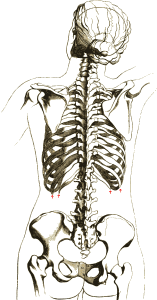Hopefully you’ve already read the blog (and watched the video) Everything You Need To Know About Low Back Pain.
Take a quick look at the skeleton diagram below. Notice how between the top crest of the hip and the bottom of the ribs, there are only 5 little bones. These are called our Lumbar Vertebrae. Doesn’t look very solid, does it? Because without the musculature surrounding it – it really isn’t that solid. This is why we need core strength.
Core strength and stability means that when we do any movement, (like sitting down, standing up, picking up a pencil, reaching for the stereo in the car) the core is engaged and stabilizing those 5 small bones. Without that stability, all those movements create small, yet repetitive traumas to our lumbar vertebrae and the joints between them. Repetitive strain injuries or repetitive movements are the most common cause of low back pain.

The following exercises will be your best line of defence against future re-injuries to the low back. Although we tend to forget about doing these exercises when we are pain free, we know that 30-40% of the people who have already sustained a low back injury will have a recurrence within 6 months to 1 year, most likely due to a lack of core stability.
The core is the initiator of all other movements.
1) Front Plank
To do a proper front plank, start by lying on your stomach on your mat or floor. Place your palms on the floor beside your chest and contract the abdominal muscles before lifting up onto your palms and toes. For those who have wrist injuries, do this on your forearms instead. Make sure that your whole body is straight and that your pelvis is neither lifted too far up or too far down. Hold 10-30 seconds, building up to 1 minute.
2) Side Plank
Lie on your side with your elbow directly underneath your shoulder. Make sure your body is in one straight line, and with your abdominals gently contracted, lift your hips off the floor, maintaining the line. Keep your hips square and your neck in line with your spine. Hold 10-30 seconds, building up to 1 minute. Alternate side and repeat. If this is too challenging, start with bent knees.
3) Bird-Dog
Begin on all fours, knees hip-width apart and under the hips, hands flat and shoulder-width apart. Squeeze your abs and focus on keeping your shoulder blades apart from each other. Keep the spine neutral, without arching the back or rotating the hips, and extend your right leg back and your left arm straight ahead. Hold for 7 seconds. Repeat 10 times per side.
4) Prone Leg Extension
This one is especially important after a low back injury. The Gluteus Maximus (bum muscles) are the most powerful muscles of the body. Unfortunately, the majority of us use them as cushions to sit on all day. Depending on your vocation, you might find that this rings especially true for you. It is important to get these muscles working properly to avoid having our low back musculature and joints compensate for the gluteus maximus’ inactivity. Lie on your stomach and squeeze your butt cheeks together. Keeping your spine and hips in line, lift your right leg 5-6 inches off the mat. Make sure the rest of your body feels stabilized and that you are not twisting. Hold for 7 seconds. Repeat 10 times per side.
5) Walking
Walking is the best exercise for low back pain hands-down. Why? Because motion is lotion. When we are walking at a fast enough pace, our arms start to swing. This is the crucial part. A good arm-swing means a cyclical activation of the musculature of the back, essentially pumping blood towards our core/low back muscles. Blood carries oxygen which is nutrition for our muscles, bones, and joints. For those of us who sit at work all day, this movement is essential for healthy spines and healthy lives. Aim for 30-60 minutes of walking, everyday!
If you have any questions, comments or concerns, please feel free to email me at drsabineanani@gmail.com